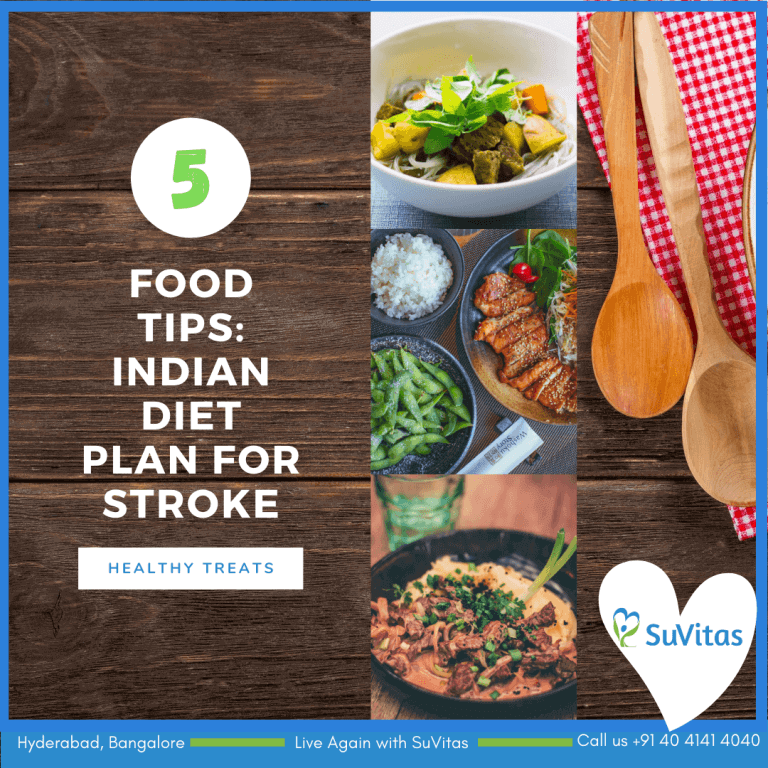Indian Diet Plan for Stroke: 5 Tips to Plan a Stroke Survivor’s Plate
It is not lifestyle choices but compromises that cause most lifestyle disorders of the day. Instead of finding time planning our meals, we settle down for convenient options. Interestingly, a recent study revealed the majority of stroke-afflicted patients in India consumed white rice, bread, pastas, noodles, pickles, packaged juices and other fast-foods. While hypertension and diabetes are assumed to be the major risk factors of stroke, irregular diet and physical inactivity could be the underlying reasons.
Higher intake of carbohydrate-rich diet can lead to Diabetes Mellitus. Similarly consumption of dietary saturated fats is associated with stroke mortality. Higher intake of salt and red meat can lead to increased blood pressure. Conversely, reduced incidence of stroke was observed among those who maintained healthy weight, consumed more total and mono-saturated fats ate green and yellow vegetables and had active lifestyles.
The fatty substances from foods form cholesterol which in turn causes fatty deposits in the arteries, restricting the flow of blood to the brain. Thus, consuming a diet rich in low fat, sodium and high in good proteins, fruits and vegetables will help in avoiding risk factors for stroke. A stroke survivor must plan his plate in such a way that triggers for another stroke is avoided.
INDIAN DIET PLAN FOR STROKE
Here are 5 Tips to Prepare an Indian Diet Plan for Stroke:
- Go responsibly- Carb: Choose your source of carbohydrates wisely. Eat more whole grains. At least half of your choices must come from these. Brown rice, whole wheat couscous etc. are high in fiber and can reduce cholesterol. Cutting down on sugar is also important to keep a check on the risk factors.
- Moderation is key: Include a variety of nutrients on your plate by incorporating a healthy dose of grains, fruits, vegetables, proteins and diary. A minimum of 5 servings of fruits and vegetables must be consumed every day.
- Watch your dressings: Salads are only as healthy as their dressings. If you top your bowl of veggies with lots of mayo and bacon, it can cause more harm than good. Limit the amount of saturated fat in your dressings by switching to olive oil, apple cider vinegar, non-fat cottage-cheese etc.
- Cut down sodium, not just salt: Most packaged foods have high sodium content. Therefore, it will be a good idea to read the label before buying products. Switch to fresh foods instead of frozen and canned substitutes. Aim to have not more than 1500 mg sodium per day in your foods.
- Stock up on stroke-preventers: Certain nutrients are known to prevent the chance of stroke like Potassium, Omega 3, Vitamin B3, CoQ10, lycopene etc. These are present in commonly available foods like bananas, fish, oatmeal, yogurt, tomatoes, apples etc.
Sample of Indian Diet Plan for Stroke:
Early Morning:
1 Glass lime juice
Handful of Roasted Flax seeds/ sunflower seeds
Breakfast:
Mixed Vegetable Oats Upma
1 Cup Mild coffee ( sugar-free with lean milk)
Mid Morning:
1 Apple/ Banana/ Orange/ Watermelon
1 Cup Green Tea
Lunch:
1 Cup of Brown rice
1 Bowl of Boiled vegetables
1 Bowl of Beetroot raita with low-fat curd
Evening:
1 Cup Mild Coffee ( Sugar-free with lean milk)
Dinner:
2 Medium Size Whole wheat Chapatis
1 Bowl of Paneer curry
1 Bowl of Cucumber Salad
Healthy food choices are a great way of reducing the risk for stroke. Whether you are looking at minimizing chances of a recurrent stroke or preventing the incidence altogether, it is time to invest on planning your diet. Diet plans must be designed in accordance with one’s nutritional requirements, risk factors and overall clinical profile.
Connect with our dietitian team to get your personalized stroke recovery/ prevention diet plan today!

